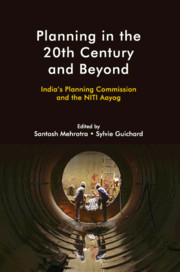Book contents
- Frontmatter
- Contents
- List of Figures
- List of Tables
- List of Abbreviations
- 1 Planning for a 21st Century India
- Part I Origins: Ideas and Ideology
- 2 From Economists to Historians: Studying the Planning Commission, 1950–2014
- 3 The Long Road to Indian Economic Planning (until 1950)
- 4 Ideas and Origins of the Planning Commission in India
- Part II Changes and Continuity: Development and Adaptation of Planning and the Planning Commission
- 5 The Planning Commission and Education
- 6 Addressing Agrarian Distress: Sops versus Development
- 7 Economic Planning after Economic Liberalization: Between Planning Commission and Think Tank NITI, 1991–2015
- 8 Planning Commission: Obiter Dictum
- 9 On a Revived Planning Commission
- Part III Planning Beyond the Planning Commission
- 10 Make in India
- 11 Manufacturing: The Cornerstone of a Planning Strategy for the 21st Century
- 12 Fiscal Planning to Sustain Growth and Poverty Reduction
- 13 Plan, but Do Not Over-plan: Lessons for NITI Aayog
- 14 Why Does India Need a Central Planning Institution in the 21st Century?
- Notes on Contributors
- Index
- References
13 - Plan, but Do Not Over-plan: Lessons for NITI Aayog
Published online by Cambridge University Press: 04 April 2020
- Frontmatter
- Contents
- List of Figures
- List of Tables
- List of Abbreviations
- 1 Planning for a 21st Century India
- Part I Origins: Ideas and Ideology
- 2 From Economists to Historians: Studying the Planning Commission, 1950–2014
- 3 The Long Road to Indian Economic Planning (until 1950)
- 4 Ideas and Origins of the Planning Commission in India
- Part II Changes and Continuity: Development and Adaptation of Planning and the Planning Commission
- 5 The Planning Commission and Education
- 6 Addressing Agrarian Distress: Sops versus Development
- 7 Economic Planning after Economic Liberalization: Between Planning Commission and Think Tank NITI, 1991–2015
- 8 Planning Commission: Obiter Dictum
- 9 On a Revived Planning Commission
- Part III Planning Beyond the Planning Commission
- 10 Make in India
- 11 Manufacturing: The Cornerstone of a Planning Strategy for the 21st Century
- 12 Fiscal Planning to Sustain Growth and Poverty Reduction
- 13 Plan, but Do Not Over-plan: Lessons for NITI Aayog
- 14 Why Does India Need a Central Planning Institution in the 21st Century?
- Notes on Contributors
- Index
- References
Summary
plus ca change, plus c’est la meme chose
—J-B. Alphonse KarrOne of the early acts of the Narendra Modi government, announced from the ramparts of the Red Fort on 15 August 2014, was the dissolution of the Planning Commission and its replacement with a new entity – the NITI Aayog. The intent was made amply clear – old-style central planning was out; new-style reforms agenda was in. With this step, India, supposedly the last surviving bastion of central planning, would join the rest of the world in embracing a market-led process of growth and development. It was certainly a bold vision, but unfortunately ahistoric. But be that as it may, it was quite clear even at the outset that the NITI Aayog would eventually have to be mandated to develop a formal strategic plan for the country, even though the nomenclature may be changed.
The inevitable has happened. The NITI Aayog has been charged with developing a 15-year vision, a 7-year strategy, and a 3-year implementation framework. Although expectedly the term ‘plan’ is scrupulously avoided, it is quite obvious that planning is back. This is a good thing. After all, the principal function of planning is to evolve a shared commitment to a common vision and an integrated strategy not only in the higher echelons of government but among all stakeholders. No development strategy can be successful unless each component of the system works towards a common purpose with the full realization of the role that it has to play within an overall structure of responsibilities. The NITI Aayog mandate meets this requirement admirably.
However, for this to happen, it is not sufficient that the vision and the strategy are clearly articulated in a formal document which is communicated and is readily available to everyone in the government, and appropriate orders are issued for compliance and implementation. Nor is it enough that all other stakeholders, in the states and in the public at large, are kept abreast through a well thought-out communications strategy. The process through which the vision and the final strategic plan are evolved and implemented can be at least as important as both the product (that is, the strategic plan) and the communication strategy.
- Type
- Chapter
- Information
- Planning in the 20th Century and BeyondIndia's Planning Commission and the NITI Aayog, pp. 264 - 282Publisher: Cambridge University PressPrint publication year: 2020



